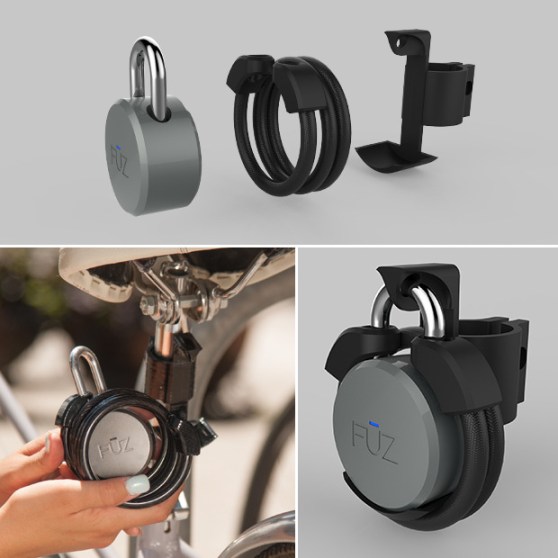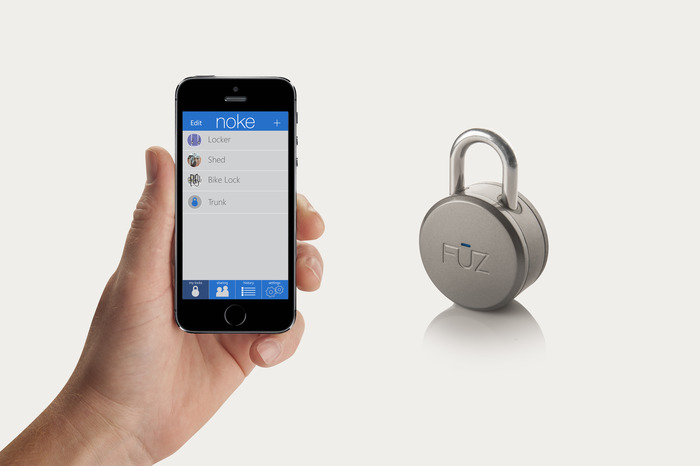Oh, the ol’ padlock. At this time of year it is on the back to school shopping lists of millions of students.
It’s also the inspiration behind the Noke by Fuz Designs, the latest runaway success project on Kickstarter.
Pronounced “No-key,” Fuz Designs (or “FŪZ” as it likes to spell itself) claims it is the “world’s first Bluetooth padlock.”
That tingled my Spidey-sense; I had the nagging feeling I’d heard about another Kickstarter Bluetooth lock project a little while back. Sure enough, there was. It was the Teo, a gadget conceived by Canadian-based Total North. It fell shy of its funding goal of $165,000 by just under $60k and it’s unknown how much longer it will take for it to get to market.
VentureBeat spoke to Fuz Designs’ cofounder, Cameron Gibbs, to find out more about the Noke and how it compares to the Teo.
First things first — about that “world’s first” label: “Well, it may very well end up being the world’s first commercially available one,” Gibbs points out. “When it comes down to it I think that’s all that really matters.”
He’s probably right. And yet the similarities between the two products are unmistakable.
On paper at least, they sound virtually identical:
- Unlocked via Bluetooth LE from an authorized smartphone
- Each lock can be given a unique name
- Access to the lock can be granted from the owner to anyone else who has a smartphone via the free app (iOS/Android)
- A replaceable, one-year battery
- A way to open the lock in the event that the battery dies
- A Kickstarter initial price point between $59 (Noke) and $79 (Teo)
- A dashboard app that simplifies access management, including the ability to see a lock’s status i.e. Open or Locked.
But the two devices couldn’t be more different in the looks department.
Total North’s Teo has a decidedly unorthodox design, looking more like the unholy offspring of a door handle and a large Ikea hex key than a traditional padlock. Not ugly by anyone’s standards, just a little odd. Gibbs thought so too, saying, “Their design missed in a few areas. They show a clip in their video with it on a locker and it just doesn’t look quite right.” It’s obvious Gibbs feels this contributed to the Teo’s failure.

Above: The TEO Bluetooth lock.
Fuz Designs’ Noke on the other hand, is a kindred spirit to the Nest Thermostat in the sense that it distills the classic combination lock down to its simplest elements: A round body and u-shaped shackle that latches vertically and swivels side-to-side.
It’s also, in my opinion, beautiful.

Above: The Noke, seen here with the optional bike mount and cable accessory.
Of course you can never underestimate the importance of price, especially in the crowdfunding world. This is an area in which Fuz Designs has plenty of experience. Its EverDock project did very well and not only exceeded its funding goal by 900 percent, it earned the company a loyal following.
“I think price point is huge difference. Ours is much more in the range that is acceptable for product like this. Also [the Teo] was based out of Canada so anyone in the U.S. who wanted one would have to pay the $15 in shipping,” Gibbs points out. No question about it — $59 with shipping included is easier to swallow than $79+ $15 for shipping. Unless you’re Canadian.
The Noke differs from the Teo from a functional perspective too. To unlock the Teo, you need to approach it with your Bluetooth enabled smartphone and trigger the lock by accessing the native app. The Noke simply requires that an authorized smartphone be within 10 feet of the lock and will release with a simple click-down movement on the shackle.
Gibbs is quick to point out that this can be easily customized from within the Noke app. “Some people want more range, some people want less range. What we’ve planned on from the beginning is to make that all customizable,” says Gibbs.
Naturally, as with any product that carries personal info, but especially with a lock, the question of security has to be addressed. Given that the Noke uses Bluetooth, could hacking be a problem?
“Nothing is ever going to be 100 percent bullet-proof. We’re going to make it as secure as possible. But there are much easier ways to hack a lock,” Gibbs points out as we both start to list off the many low-tech methods for compromising a small padlock. Which is not to say that Fuz Designs has ignored the need for physical protection. Its Kickstarter page claims that the Noke “uses the latest in anti-shim technology so you need not worry about thieves trying to use a shim to open your lock.”
Interestingly, this is an area of the Teo’s design that Gibbs is critical of. “It’s pretty easy to pick. If you just took a screwdriver […] you could pull their shank out of their lock,” he claims.
Perhaps the biggest difference between the two products is a very clever alternative method for unlocking the Noke should you be without your phone or your phone’s battery dies. A patent-pending Morse code series of long and short clicks, which Fuz calls “Quick Click”, can be assigned to your Noke, which you enter by simply pushing down on the shackle once for each click. Complete the sequence correctly and the external LED goes from red to green as the mechanism disengages.
The Noke project is only in its second day on Kickstarter and yet it has already surpassed its $100,000 goal.
“The lock was something that felt like it should already have existed, and it doesn’t,” says Gibbs. Clearly the crowdfunding community agrees.
He also sees the Noke as the start of a larger effort: “This is a product that is really more of a business than a single product. We can develop locks for other industries. Bigger locks, smaller locks, luggage locks etc.”
There are definitely grounds for his optimism.
MasterLock, the world’s largest maker of padlocks, sells 50 million of these things every year. Many are replacements for forgotten combinations (something that Noke clearly eliminates) but many aren’t.
When asked what the future held for Fuz Designs, Gibbs offered VentureBeat an exclusive peek at their next Kickstarter project: A case for the iPhone 6.
If that sounds obvious or boring or unimaginative for a company like Fuz, wait for the punchline: It plans on launching its case’s Kickstarter the day Apple announces the next iPhone — and will terminate it and start shipping the cases to backers on the same day the iPhone 6 hits retail. That’s a period of time Gibbs estimates to be a week and half.
This will make the Fuz Designs case — which will incorporate a felt material into its design — the very first one for the iPhone 6 in people’s hands, assuming that Apple doesn’t launch one of its own at the same time.


